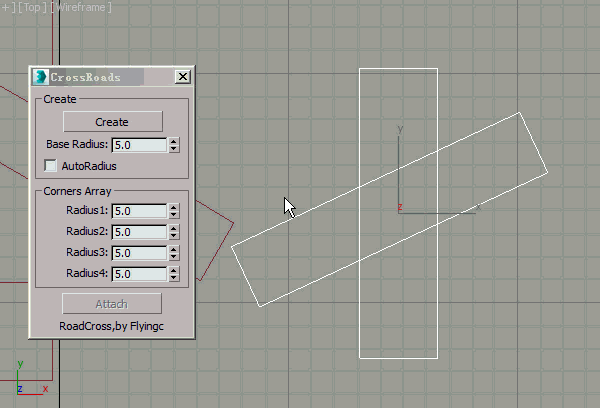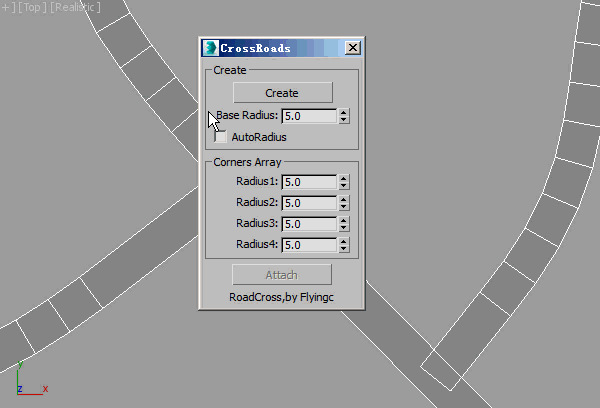Accurate Elevations for France ?
- Thread starter r@m
- Start date
Pixelchaser
Well-Known Member
I'm a vert to the left side and a vert to the right, and if I wana go overkill ill put 1 in the middle.for a non concave (flat road) of course a city circuit demands more,
how long are your roads combined roughly ?
I do like this method for street etc.
how long are your roads combined roughly ?
I do like this method for street etc.
r@m
Active Member
6.5 miles - 10597mhow long are your roads combined roughly ?
Willy Wale
Member
Hmmm, I had made all the roads but recently decided to do them all againPics or it didn't happen
/sorry, had to

Here is one such junction. Green line (marvel at my MS Paint skills) is the short layout. Orange line is the longer layout.

Above in Blender. I haven't finished (clearly) but you can see that I went with the S bend of the short layout. 1m segments, array then curve modifier along a bezier. Now though, you guys have got me thinking that I should start the junctions again.
Here's another one.

WW
Mr Whippy
Active Member
I might have to buy this and try it out and see how close it gets vs doing it fairly manually.Yup, make a spline shape, normalise the splines around it's edges to 1m and be amazed
If it polishes off the 90% of work instantly, that might be nice. But as you know cities are full of junctions and blends. It's those bits where I spend most of my time
1m for visual should be fine. For a city you'd also break it up too. You might only see 250m chunks or so at a time, so others can be turned off.I just see the start of a 1 metre spaced road mesh, which great for starting the physics layers, but isn't it overkill for any visual mesh ? it all adds up that's all I know. post #73
Chances are for many roads, it's either curving, arcing up hill, down hill, or camber or crowning, so the cases for going lower density will exist, but are probably not going to save you huge poly counts vs the risk of seeing too sharp angles.
You could probably go through a mesh later with a smart algorithm to strip out quads with low angle differential between them, or do it manually by eye.
10m wide city is 20 triangles per 1m distance. 10km of street is 10,000 * 20, so about 200,000 polys, of which 50% to 75% can be turned off if you split it nicely.
There are worse areas in AC for wasteful use of hardware and author time. Ie, AC's crappy 15 year old approach to grass!
Mr Whippy
Active Member
I'd work racing route agnostically.Hmmm, I had made all the roads but recently decided to do them all again. I'm learning Blender as I go. I haven't got anything as nice as r@m to show. However...
View attachment 1664
Here is one such junction. Green line (marvel at my MS Paint skills) is the short layout. Orange line is the longer layout.
View attachment 1665
Above in Blender. I haven't finished (clearly) but you can see that I went with the S bend of the short layout. 1m segments, array then curve modifier along a bezier. Now though, you guys have got me thinking that I should start the junctions again.
Here's another one.
View attachment 1666
WW
Make a nice control mesh for the Z data which is just smooth and Z correct, but isn't necessarily correct in XY.
Then have an XY correct quad mesh that 'flows' nicely and takes in all the surrounding junctions and so on. That then conforms or gets projected down easily onto the Z mesh.
You can then tweak the Z mesh easily and get smooth results if needed, and then re-drop the denser (1m quad ish) XY mesh onto it easily.
Build the roads first, decals etc etc, and then add your race course over the top.
The main reason I say this is that if you change the race route, it just works. You can shift barriers, fences, kerbs etc, and everything underneath can be left alone.
Also the street course has crowns/cambers based on the flow of the real roads flows, not the flow of the race course you're setting.
So having a poly structure running in the directions of the actual road is ideal, rather than running in the direction of a loft flow for your race route.
This is a 1m grid city track area I've been making (Leeds Loops) and as you can see all the polygons flow where needed, and curves are fanned in where needed.
The Z data is on a different control mesh (that controls terrain flows, camber and crown)
This mesh is never touched once it's created. It just gets dropped down onto the Z control mesh to 'tweak' the Z position.
This is just my approach which I find works the best. It's a lot of work but it gives really solid, smooth, realistic and controllable results.
r@m
Active Member
Yup, track first and expand from that seems best.
I'm just experimenting with methods and trying to keep it as simple as possible, I'm currently combining splines created from the track sides with splines curves created from OSM data.
I had been creating splines directly from the OSM mesh which always resulted in messy splines that needed cleaning/optimising/normalising etc, it seemed the quickest way to go but all the post work cancels that out.
...anyway, I now snap new splines to the OSM outline so I can control the segments better and eliminate all the "spline faff".
3m squares for the track, 1m for curves and corners
...crispy clean track with watertight kerbs , I know the game triangulates everything but my eyes need to see polygons...I've yet to settle on the best method for curves and corners.
, I know the game triangulates everything but my eyes need to see polygons...I've yet to settle on the best method for curves and corners.

Here's an example, the OSM data is rough and jagged, but the mesh produced by splinetrackmaker is smooth and even:

Same area but with the curves from the track mesh...I just don't like looking at messy triangles

I'm just experimenting with methods and trying to keep it as simple as possible, I'm currently combining splines created from the track sides with splines curves created from OSM data.
I had been creating splines directly from the OSM mesh which always resulted in messy splines that needed cleaning/optimising/normalising etc, it seemed the quickest way to go but all the post work cancels that out.
...anyway, I now snap new splines to the OSM outline so I can control the segments better and eliminate all the "spline faff".
3m squares for the track, 1m for curves and corners
...crispy clean track with watertight kerbs
Here's an example, the OSM data is rough and jagged, but the mesh produced by splinetrackmaker is smooth and even:
Same area but with the curves from the track mesh...I just don't like looking at messy triangles
Last edited:
r@m
Active Member
Have you heard of terrain axe ?
http://www.flyingcfx.com/
Ridiculous price, but looks to have a couple of good tools.


edit: actually that's not so impressive, he's just booleaning spline shapes and filleting, easy to do manually
http://www.flyingcfx.com/
Ridiculous price, but looks to have a couple of good tools.


edit: actually that's not so impressive, he's just booleaning spline shapes and filleting, easy to do manually
Mr Whippy
Active Member
The problem I always find is that fillets aren't always perfect.
Spline outlining my Leeds course for example, almost every corner I filleted I had to then go in and adjust handles and stuff.
Maybe in 'perfect city land' this tool would be useful. But cities aren't perfect.
Infact I'd go as far as saying it's the subtle details you get right, that are a pita, that make things feel 'right'
Plus this is great for 'flat' stuff, but without elegant topology over it, how does it look when you add some hills?
I bet Marius Silaghi's quad hole cap pro thingy, with well managed spline workflow, is going to be the best for this kinda task.
Spline outlining my Leeds course for example, almost every corner I filleted I had to then go in and adjust handles and stuff.
Maybe in 'perfect city land' this tool would be useful. But cities aren't perfect.
Infact I'd go as far as saying it's the subtle details you get right, that are a pita, that make things feel 'right'
Plus this is great for 'flat' stuff, but without elegant topology over it, how does it look when you add some hills?
I bet Marius Silaghi's quad hole cap pro thingy, with well managed spline workflow, is going to be the best for this kinda task.

